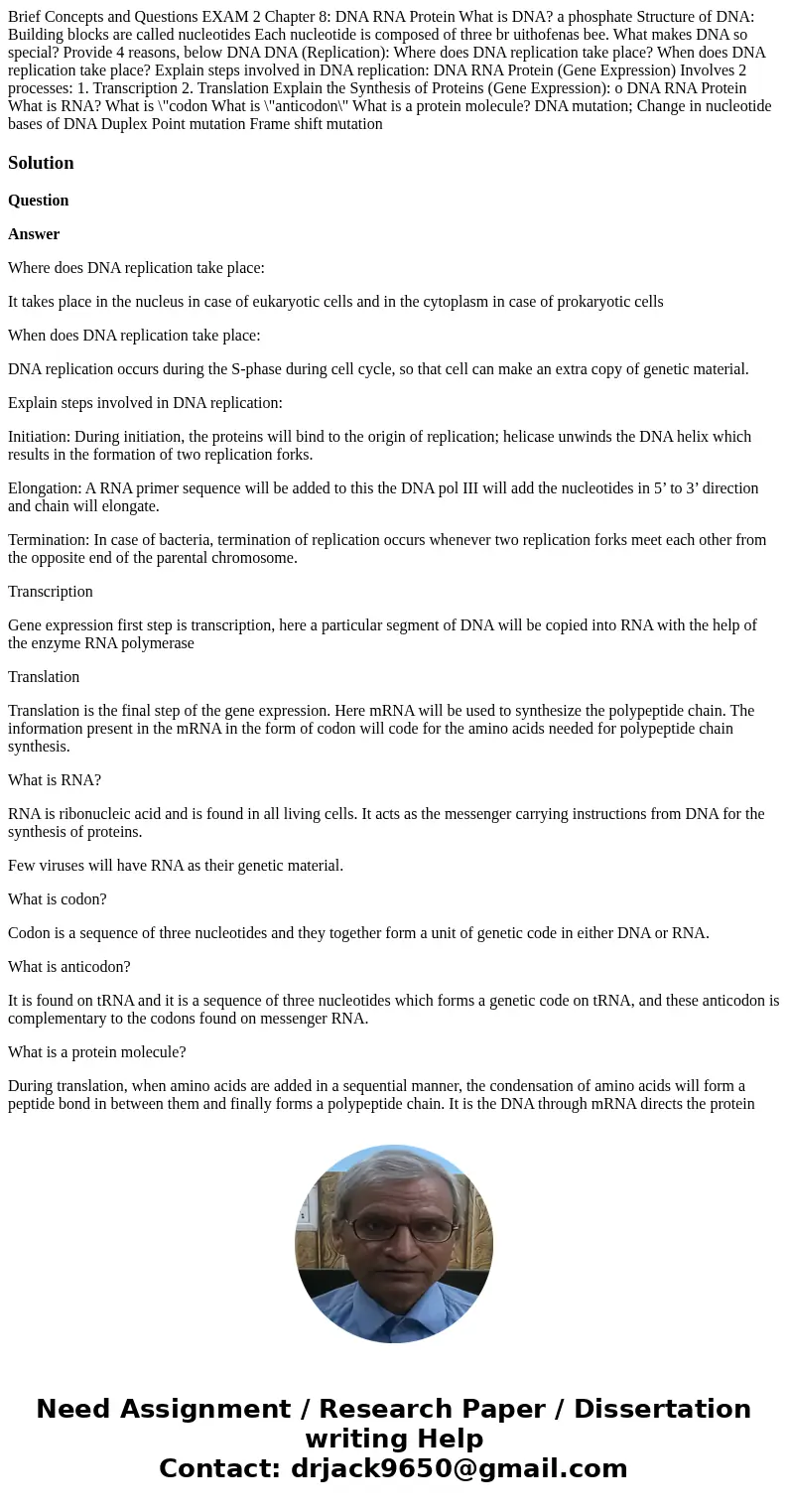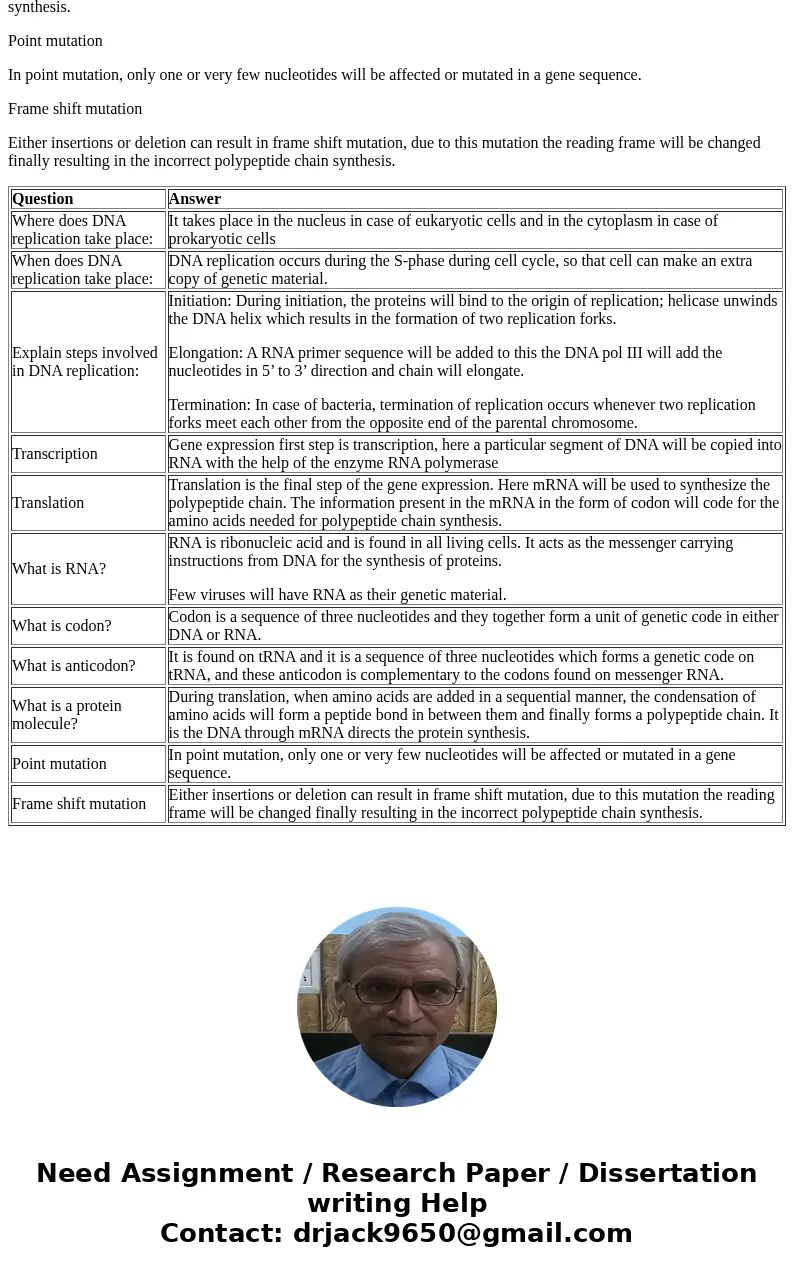Brief Concepts and Questions EXAM 2 Chapter 8 DNA RNA Protei
Solution
Question
Answer
Where does DNA replication take place:
It takes place in the nucleus in case of eukaryotic cells and in the cytoplasm in case of prokaryotic cells
When does DNA replication take place:
DNA replication occurs during the S-phase during cell cycle, so that cell can make an extra copy of genetic material.
Explain steps involved in DNA replication:
Initiation: During initiation, the proteins will bind to the origin of replication; helicase unwinds the DNA helix which results in the formation of two replication forks.
Elongation: A RNA primer sequence will be added to this the DNA pol III will add the nucleotides in 5’ to 3’ direction and chain will elongate.
Termination: In case of bacteria, termination of replication occurs whenever two replication forks meet each other from the opposite end of the parental chromosome.
Transcription
Gene expression first step is transcription, here a particular segment of DNA will be copied into RNA with the help of the enzyme RNA polymerase
Translation
Translation is the final step of the gene expression. Here mRNA will be used to synthesize the polypeptide chain. The information present in the mRNA in the form of codon will code for the amino acids needed for polypeptide chain synthesis.
What is RNA?
RNA is ribonucleic acid and is found in all living cells. It acts as the messenger carrying instructions from DNA for the synthesis of proteins.
Few viruses will have RNA as their genetic material.
What is codon?
Codon is a sequence of three nucleotides and they together form a unit of genetic code in either DNA or RNA.
What is anticodon?
It is found on tRNA and it is a sequence of three nucleotides which forms a genetic code on tRNA, and these anticodon is complementary to the codons found on messenger RNA.
What is a protein molecule?
During translation, when amino acids are added in a sequential manner, the condensation of amino acids will form a peptide bond in between them and finally forms a polypeptide chain. It is the DNA through mRNA directs the protein synthesis.
Point mutation
In point mutation, only one or very few nucleotides will be affected or mutated in a gene sequence.
Frame shift mutation
Either insertions or deletion can result in frame shift mutation, due to this mutation the reading frame will be changed finally resulting in the incorrect polypeptide chain synthesis.
| Question | Answer |
| Where does DNA replication take place: | It takes place in the nucleus in case of eukaryotic cells and in the cytoplasm in case of prokaryotic cells |
| When does DNA replication take place: | DNA replication occurs during the S-phase during cell cycle, so that cell can make an extra copy of genetic material. |
| Explain steps involved in DNA replication: | Initiation: During initiation, the proteins will bind to the origin of replication; helicase unwinds the DNA helix which results in the formation of two replication forks. Elongation: A RNA primer sequence will be added to this the DNA pol III will add the nucleotides in 5’ to 3’ direction and chain will elongate. Termination: In case of bacteria, termination of replication occurs whenever two replication forks meet each other from the opposite end of the parental chromosome. |
| Transcription | Gene expression first step is transcription, here a particular segment of DNA will be copied into RNA with the help of the enzyme RNA polymerase |
| Translation | Translation is the final step of the gene expression. Here mRNA will be used to synthesize the polypeptide chain. The information present in the mRNA in the form of codon will code for the amino acids needed for polypeptide chain synthesis. |
| What is RNA? | RNA is ribonucleic acid and is found in all living cells. It acts as the messenger carrying instructions from DNA for the synthesis of proteins. Few viruses will have RNA as their genetic material. |
| What is codon? | Codon is a sequence of three nucleotides and they together form a unit of genetic code in either DNA or RNA. |
| What is anticodon? | It is found on tRNA and it is a sequence of three nucleotides which forms a genetic code on tRNA, and these anticodon is complementary to the codons found on messenger RNA. |
| What is a protein molecule? | During translation, when amino acids are added in a sequential manner, the condensation of amino acids will form a peptide bond in between them and finally forms a polypeptide chain. It is the DNA through mRNA directs the protein synthesis. |
| Point mutation | In point mutation, only one or very few nucleotides will be affected or mutated in a gene sequence. |
| Frame shift mutation | Either insertions or deletion can result in frame shift mutation, due to this mutation the reading frame will be changed finally resulting in the incorrect polypeptide chain synthesis. |


 Homework Sourse
Homework Sourse